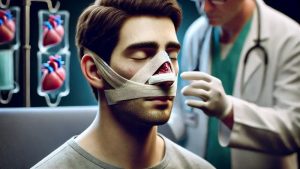Damaged nose repair due to impact, accident or other injuries
Introduction
The nose is one of the most common areas of the body due to its central position on the face, which is subject to injuries caused by trauma, accident and other injuries.. Nasal fractures and damage to its internal structures can cause functional problems (Such as respiratory obstruction) And make the appearance of appearance. Nose regeneration after injury, a combination of plastic surgical skills and 乇蹖賳賵倬賱丕爻鬲蹖 (毓賲賱 夭蹖亘丕蹖蹖 亘蹖賳蹖) Is aimed at restoring the normal function of the nose and modifying the appearance of appearance. In this article from the site of Dr. Behnam Khorrami (Isfahan nose surgeon _ Jaw surgeon of Isfahan)Different aspects of post -injury nasal reconstruction are discussed, including causes, diagnosis, surgical procedures and postoperative care..
Causes and types of nose damage
Nasal damage can be caused by various factors that are generally divided into three categories.:
Traumatic damage
Straight beat (Fist, falling, dealing with a hard object)
Traffic accidents
Sports injuries (Like football, boxing)
Penetrating injuries
Knife -related wounds or sharp objects
Bullet wounds
Damage caused by previous surgery or medical errors
Complications caused by previous rhinoplasty
Incomplete repair Fractures Previous
Symptoms and symptoms of fracture and nasal damage
Nose damage is usually associated with the following symptoms:
Swelling and bruising around the nose and under the eyes
Nose appearance (Tilting)
nose bleeding (丕倬蹖爻鬲丕讴爻蹖)
Nasal obstruction (Difficulty breathing)
Pain and sensitivity to touch
If the exact cause and location of the bleeding cannot be determined, the nasal artery should be surgically blocked. (The formation of blood clots in nasal septum)
Diagnosis of nasal damage
Accurate diagnosis of nasal injuries is essential for proper treatment planning. The following tools are used to evaluate the severity of injury:
1. Clinical examination
By touching and observing the external and internal structures of the nose, the doctor examines swelling, sensitivity and obstruction of the respiratory tracts.
2. Medical imaging
Radiography (X-ray): To evaluate bone fractures
CT Scan (CT scan): To make a closer examination of complex fractures and damage to internal structures
MRI: If suspicious of soft tissue or cartilage damage
Treatment and regeneration methods after injury
1. Non -surgical treatment
In cases of mild injuries, non -surgical treatments include the following:
cold compress: To reduce inflation
Anti -inflammatory and painkiller drugs: To reduce pain and inflammation
Putting the package (Closed Reduction): If the fracture is mild, the nose can be remained with no open surgery..
2. Surgical treatment (Nose regeneration)
Reconstruction surgery is essential in cases of severe injuries or complex fractures. These methods include the following:
(A)) Open (Open Reduction)
In case of complex fractures, the nasal bones are in place with open surgery and under general anesthesia..
(B)) 爻倬鬲賵倬賱丕爻鬲蹖 (Septoplasty)
In case of damage to the nose blade (爻倬鬲賵賲), Septoplasty is done to correct respiratory obstruction.
During this procedure, the doctor reconstructs the cartilage and the damaged bone and puts the septum in the correct position..
噩) 乇蹖賳賵倬賱丕爻鬲蹖 (Rhinoplasty)
Rhinoplasty techniques are used to modify the nasal shape if the nose is deformed..
This procedure may include bone regeneration and cartilage, tissue transplantation and skin correction.
丿) Reconstruction using cartilage bonding
If the cartilage or bone disappears may be used, the nasal cartilage may be used to regenerate.
E) Engineer (Turbinectomy)
If mucosa or turbines (Nasal tentacles) They are swollen because of the injury, shrinking them by doing the turbine, and opening the respiratory tract..
Post-operative care
1. Initial actions
Use cold compresses to reduce bruising and swelling
Taking analgesic and anti -inflammatory drugs according to your doctor's prescription
Avoid finishing and pushing to the nose
2. The protection of the reconstructed structure
Avoid heavy exercise and intense physical activity for 6 weeks
Avoid sleeping on the side or on the nose
3. Medical follow -up
Regular examination by a physician to evaluate the condition of recovery
In case of infection or bleeding, immediate referral to your doctor
Possible complications after nose reconstruction
Infection at the surgical site
Hematoma (Blood accumulation in tissues)
Failure to completely modify the nose deformity
Continuous respiratory problems
Damage to the sense of smell
Long -term results of nose recreation
In most cases, nasal reconstruction is successful after injury. Long -term results include the following:
Improve respiratory function and reduce nasal obstruction
Correction of the appearance of the nose
Restore facial symmetry
Increased patient's self -esteem

Conclusion
Post -traumatic nose recreation is a complex process that requires the expertise of plastic surgeons, ear and nose and nose (ENT) Is. Accurate diagnosis, choosing the right treatment and post -operative care play a key role in the success of treatment.
Useful links:
Isfahan nose surgeon _ Jaw surgeon of Isfahan
Dr. Behnam Khorrami's page in the clinic 24 | Maxillofacial surgeon in Isfahan clinic 24 | Nose surgeon in Isfahan clinic 24
Dr. Behnam Khorrami, nose surgeon in Isfahan at Dr. Af | Maxillofacial surgeon in Isfahan at Dr. Af | Isfahan nose surgeon at Dr. Af